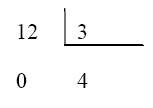Divisors of a number
If we take any two integers, for example,

Let us use tables to represent the divisions:
|
|
|
|
|
|
The resulting quotient, number
Now, if we take any other two numbers, for example,
|
|
|
|
|
|
In this case, we obtain a remainder, number
If we try to divide different numbers, we will see that in some cases we obtain exact divisions and in other cases non exact divisions.
Example
If the number
So, we would say that one number is a divisor of another one if the division of this second one by the first one (the divisor) results in an exact division.
Example
The divisors of number
Example
The divisors of number
Example
The divisors of number
Example
The divisors of number
As we see in these examples, the divisors of a number will always be less than this number. Number
Multiples of a number
If we take one of the previous examples, for instance number
A number is a multiple of another one when the latter can be multiplied by a third number to obtain the first one.
In this case, we can say, for example, that
In the same way,
In the other examples, and doing the multiplications of divisors which result is the original number, like
As we can see in the examples, any number (other than zero) is a multiple of itself and of the unit (i.e.,
